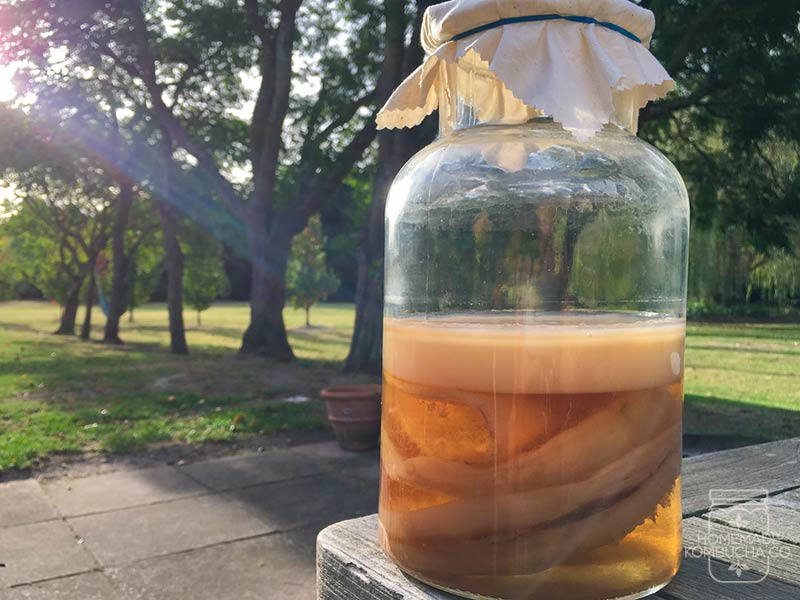A lot of people ask us how they look after a SCOBY if they go on holidays – the simple answer is make a SCOBY hotel. But before we get into that, let’s just quickly refresh on what a SCOBY is and what it needs to survive.
A SCOBY is a symbiotic culture of bacteria and yeast. The microbes feed off sweet tea and make the thick ‘pellicle’ (which basically means skin in latin) out of cellulose as a byproduct of the fermentation process. A SCOBY is alive, which means it needs food (sweet tea), oxygen and a safe, clean place to survive and happily brew you a supply of kombucha.
It is important for the SCOBY to live in a dark environment with a relatively stable temperature – they prefer between 20-25°C. Keep the SCOBY free from dust, mould and other contaminants with a decent cotton muslin cloth.
How do I store a SCOBY long term?
Most people brew their kombucha for roughly two weeks before drinking – however a SCOBY will happily sit in a brew for around 4-6 weeks. Keep in mind as the SCOBY digests the sugar then the brew will become less sweet and more acidic. You probably won’t like the taste of kombucha that has been brewed for six weeks – use it for vinegar instead or just keep it as a starter culture when you are ready to start brewing again.
If you’ve followed our instructions and have the correct levels of sugar in your brew the SCOBY will happily chug along whilst you ignore it. So don’t stress if you are going away on a short holiday – your SCOBY will be fine.
If you are planning to be leave your SCOBY for 6-8 weeks or longer then your best bet is to build a SCOBY hotel. We will explain this process shortly.
How long can a SCOBY survive?
This is an important question to ask and the answer is – it depends! In proper conditions the SCOBY can live indefinitely, but in a typical home brewing environment the yeast can sometimes get a little out of control. This will not actually kill the SCOBY, but you are best straining out all of the yeast strands to keep things balanced.
A SCOBY that has not been fed for a while will use up all available sugar over about eight weeks and then go dormant for a while. Eventually though, the bacteria and yeast will need to eat so the culture will begin to die off and eventually the SCOBY will turn black and rot. SCOBY death will happen much faster if the temperatures are not ideal – cold can kill off the microbes and heat will cause them to eat through their food source quicker, and then begin to starve earlier.
We have had packages lost by Australia Post and then returned to us about two months later. The poor SCOBY had been vacuum sealed for that whole time without an oxygen supply. The vacuum sealed pouch had blown up because of the carbon dioxide produced through fermentation, but when we opened it – things smelled vinegary but not rotten. We tested this SCOBY to see if it would still brew properly, and it did take a bit longer than normal, but in the end we got a decent kombucha from it. The lesson learned from this is that the SCOBYs are quite resilient, and to kill the culture requires some pretty serious mistakes.
So what is a SCOBY hotel?
A SCOBY hotel is a large jar where you can stack multiple SCOBYs in layers. Normally you would want to make sure there is adequate food (sugar and nutrients from the tea) and it is a good idea to weight the SCOBY’s down with a sterilised fermentation weight or something similar. This will make sure the top SCOBY doesn’t get pushed up out of the liquid by the carbon dioxide produced during fermentation. If this happens the SCOBY can dry out and won’t be protected by the acidity levels of the kombucha, which is definitely not ideal.

Here is a green tea SCOBY hotel after we came back from a three week break. Normally a new SCOBY will form on the surface of the liquid whilst you are away.
How do I make a SCOBY hotel?
Step 1:
Get a very large, sterile jar – ideally with a wide mouth. 4L is a good starting point, although it really depends on how many SCOBYs you are going to house in the hotel.
Step 2:
Get your SCOBY’s together, add them into the jar and pour enough starter culture (finished kombucha) into the jar to cover up to about half of the SCOBY’s. Keep in mind that you need to leave a fair bit of space for their long term food source and oxygen at the top of the jar. You do not want to have the jar more than about three quarters full when your SCOBY hotel is finished.
Step 3:
Brew a small batch of sweet tea using your organic tea and organic sugar and let it cool to room temperature. You will need enough tea to fill the remaining 50% required to cover the SCOBY’s in liquid. So, if you need 2L of liquid to completely submerge all the SCOBY’s in the hotel, you will need 1L of starter culture (step 2) and then 1L of sweet tea (step 3). Pour the cooled sweet tea into the jar to cover the SCOBY’s.
Step 4:
Use your cotton muslin cloth to cover up the mouth of the jar, place your SCOBY hotel in a clean, cool, dark space and you are done! Cooler temperatures will slow the fermentation process, the normal temperature range from brewing is between 20°C and 25°C. Around 18°C would be fine for the hotel.
Step 5:
SCOBY hotel maintenance: after about eight weeks it is a good idea to top up the food source for the hotel. Pour off about half of the liquid and pour in a new batch of cooled sweet tea to keep the SCOBY’s feeding.
To look after your SCOBY long term – don’t do these things!
Put it in the fridge:
Some people think that putting a SCOBY in the fridge will slow the fermentation process down and put everything into hibernation mode. Unfortunately, the microbes that produce kombucha are sensitive to cold and will actually become weakened and eventually killed off if they spend more than a couple of days in the fridge.
If you put your SCOBY’s (or even worse a SCOBY hotel) in the fridge, there are pretty high chances that your culture will be compromised and mould will take over. You really don’t want to come back from a holiday to find your whole kombucha brewing pals mouldy!
Dehydrate the SCOBY:
It is fairly common to see dehydration recommended as a storage technique for SCOBY’s, but we do not recommend this. Once a SCOBY has been dried out the chances of mould contamination become much, much greater which can be potentially dangerous. A lot of dehydrated SCOBY’s will fail, and if they do come back to life the kombucha normally tastes a fair bit worse than brews produced with a healthy SCOBY.

